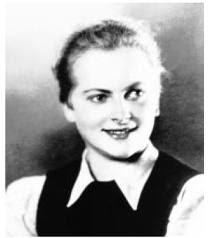It was Friday the thirteenth and there werethirteen prisoners, all of them awaiting execution.
They had been dubbed the ‘Beasts ofBelsen’: 10 men and three women who had sent tens of thousands of concentrationcamp victims to their deaths. Now, it was their turn to die.
Pierrepoint's most celebrated executions came in the wake of the Nazi war crime trial of the 'beasts of Belsen. The convicted prisoners included Irma Grese, a vivacious young blond girl who'd joined the SS at an early age and worked enthusiastically at Belsen, lashing herJewish prisoners to death with her riding whip before they reached the gaschambers.
He then went inside the prison to meet thecondemned men and women. ‘I walked down the corridor and the thirteen Belsenfaces were pressed close to the bars.’
The next prisoner, Dr Fritz Klein, had been convicted of killing up to 300victims at a time in the gas chambers. Pierrepoint found him full of energy and not a bit contrite. ‘[He] came walkingbriskly down the corridor and efficiently complied with the formalities.’
First to go were Josef Kramer and FritzKlein. They were roped together and also roped by their necks. ‘I adjusted theropes and flew to the lever,’ recalled Pierrepoint. Twenty five seconds later,both were dead.
The executions took many hours and it was dark by the time all the prisonershad been despatched. Pierrepoint was exhausted but he nevertheless went to amess party that night. He was proud to have hanged the ‘Beasts of Belsen’.
 |
| Albert Pierrepoint: a very British hangman |
There was never any doubt as to who wouldundertake the executions: Albert Pierrepoint was Britain’s most experiencedhangman. He had got the job of executioner in 1932, following in the footstepsof his father and uncle. He'd proved so reliable and efficient that within nine years he waspromoted to Chief Executioner. He even perfected the art of doubleexecutions, hanging two men at the same time.
 |
| Guilty: the beasts of Belsen |
Also convicted was Juana Bormann, who had treated her prisoners with horrific violence, setting her vicious Alsatianon the weak and sickly. Many of them were gnawed to death.
‘First she egged the dog on and it pulledat the woman [victim’s] clothes,’ said one of the witnesses at her trial. ‘Then she wasnot satisfied with that and made the dog go for her throat.’
Albert Pierrepoint had executed scores ofpeople over the previous decade but he had never hanged 13 in one day and norhad he despatched anyone quite so evil as this bunch. He was particularly keen to meet IrmaGrese, whom he regarded as the worst of the lot.
‘She walked out of her cell and cametowards us laughing,’ he wrote. ‘She seemed as bonny a girl as one could everwish to meet.’
When asked her age, she paused and smiled.Pierrepoint also found himself smiling, ‘as if we realised the conventionalembarrassment of a woman revealing her age.’
These ‘Belsen’ executions were to be ratherdifferent from Pierrepoint’s previous ones. He was put in total charge frombeginning to end - a job that required meticulous planning. ‘I had to supervisethe weighings and measuring of the condemned thirteen in order to work out mydrops.’
He had never done this before: in Britainit was done by prison officers.
When Pierrepoint had first arrived at Buckeburgprison, where the criminals were held, he was appalled to see 13 graves being dug for the condemned prisoners.
He felt that this was unseemly. ‘I complainedabout it to a prison official but was told that nothing could be done to stopit.’
 |
| Timothy Spall is Pierrepoint the in movie |
Pierrepoint was taken aback. ‘Never in myexperience have I seen a more pitiable crowd of condemned prisoners.’
The first to be weighed and measured wasJosef Kramer, who had killed thousands of victims. He was sullen and gave monosyllabic answers to Pierrepoint’s questions.
 |
| Kramer: no regrets |
Once all the prisoners had been weighed,Pierrepoint had to work out the length of rope. If the drop was too long, itwould tear their heads off. Too short and it might not kill them.
Pierrepoint was woken at 6am on Friday 13December, 1945. He decided to execute the women first, beginning with IrmaGrese. She proved a model of calmness, walking slowly to the trap and standing onthe white chalk mark.
‘As I placed the white cap over her head, she said in herlanguid voice: ‘Schnell.’’ The trapdoor crashed from under her feet and herbody twisted as the rope broke her neck. Pierrepoint’s first prisoner was dead.
‘As I placed the white cap over her head, she said in herlanguid voice: ‘Schnell.’’ The trapdoor crashed from under her feet and herbody twisted as the rope broke her neck. Pierrepoint’s first prisoner was dead.
He hanged the two other women beforepausing for a refreshing cup of tea. Then, he set to work on the men, adjusting thescaffold for the double executions.
 |
| Always keep a note of your executions |
The executions took many hours and it was dark by the time all the prisonershad been despatched. Pierrepoint was exhausted but he nevertheless went to amess party that night. He was proud to have hanged the ‘Beasts of Belsen’.
He would subsequently be appointed to executea further 190 Nazi war criminals, including Bruno Tesch, inventor of the gasZyklon B. Pierrepoint was by now so efficient at his job that he could despatch his clients - cell togallows - in under 60 seconds.
Pierrepoint was eventually retired at theage of 72, due to failing eyesight. Home Office officials cancelled hiscontract when they learned that he almost noosed his assistant and sent him through thetrapdoor by mistake.
 |
| UK paperback |
NOW PUBLISHED IN PAPERBACK
Wolfram: The Boy Who Went to War available here for just £5.30
And for my American readers, it is now published under the title: The Boy Who Went to War: The Story of a Reluctant German Soldier in WWII available here







